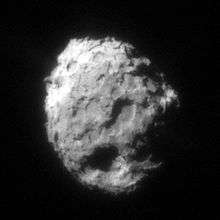20D/Westphal
| Discovery | |
|---|---|
| Discovered by | J. G. Westphal |
| Discovery date | July 24, 1852 |
| Alternative designations |
21P/1852 O1; 1852 IV; 21P/1913 S1; 1913 VI; 1913d |
| Orbital characteristics A | |
| Epoch | 1913-11-09 (JD 2420080.5) |
| Aphelion | 30.030 AU |
| Perihelion | 1.2540 AU |
| Semi-major axis | 15.642 AU |
| Eccentricity | 0.9198 |
| Orbital period | 61.87 yr |
| Inclination | 40.890° |
| Last perihelion | January 3, 1976[1] (unobserved) |
| Next perihelion |
May 4, 2038[1] (lost) |
20D/Westphal was a periodic comet with an orbital period of 61 years. It fits the classical definition of a Halley-type comet with (20 years < period < 200 years).[2] It was originally discovered by the German astronomer J. G. Westphal (Göttingen, Germany) on July 24, 1852.
It was independently discovered by the American astronomer Christian Heinrich Friedrich Peters (Constantinople) on August 9.
The comet was last seen between September 27 and November 26, 1913, first by Pablo T. Delavan (La Plata Astronomical Observatory) and then others. It was predicted to return in 1976[1] but was never observed, and is now considered a lost comet.
References
- 1 2 3 Seiichi Yoshida (2004-02-21). "20D/Westphal". Seiichi Yoshida's Comet Catalog. Retrieved 2012-02-20.
- ↑ "JPL Small-Body Database Browser: 20D/Westphal" (1913-10-13 last obs). Jet Propulsion Laboratory. Retrieved 2012-07-26.
External links
- Orbital simulation from JPL (Java) / Horizons Ephemeris
- 20D/Westphal, Comet Orbit Home Page
- 20D at Kronk's Cometography
- Orbital elements, Infrared Processing and Analysis Center
| Numbered comets | ||
|---|---|---|
| Previous 19P/Borrelly |
20D/Westphal | Next 21P/Giacobini–Zinner |
This article is issued from Wikipedia - version of the 3/28/2016. The text is available under the Creative Commons Attribution/Share Alike but additional terms may apply for the media files.

